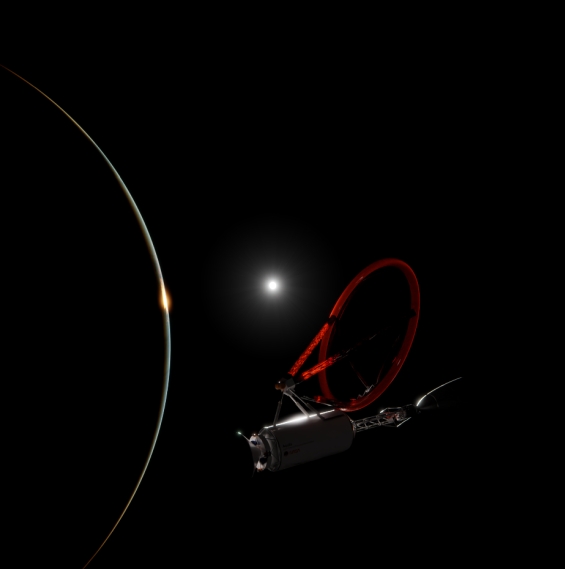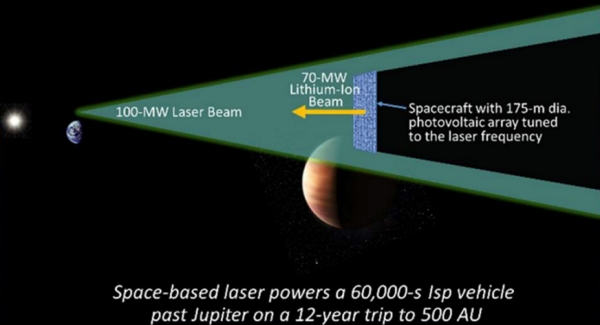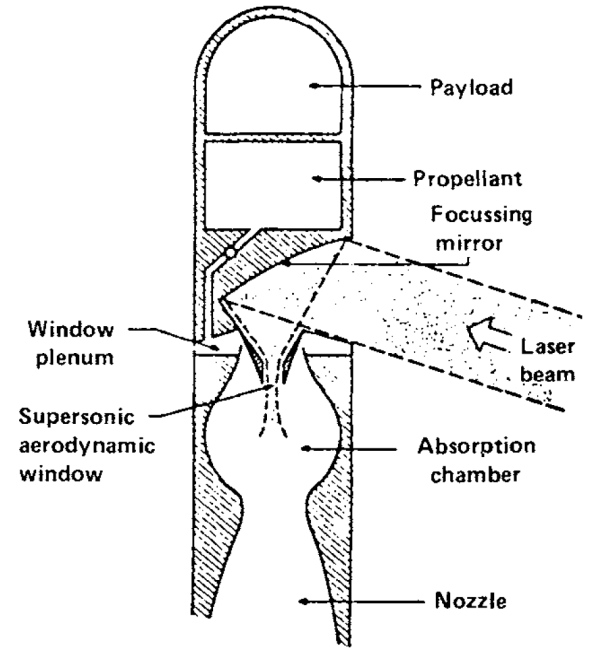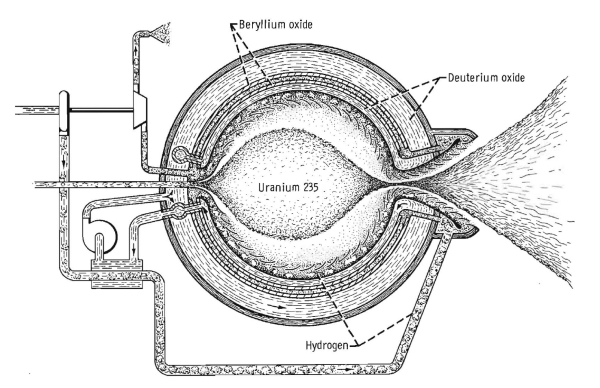Do the laser thermal concepts we discussed earlier this week have an interstellar future? To find out, applications closer to home will have to be tested and deployed as the technology evolves. Today we look at the work of Andrew Higgins and team at McGill University (Montreal), whose concept of a Mars mission using these methods is much in the news. Dr. Higgins is a professor of Mechanical Engineering at the university, where he teaches courses in the discipline of thermofluids. He has 30 years of experience in shock wave experimentation and modeling, with applications to advanced aerospace propulsion and fusion energy. His background includes a PhD (’96) and MS (’93) in Aeronautics and Astronautics from the University of Washington, Seattle, and a BS (’91) in Aeronautical and Astronautical Engineering from the University of Illinois in Urbana/Champaign. Today’s article is the first of two.
by Andrew Higgins

Directed energy propulsion continues to be the most plausible, near-term method by which we might send a probe to the closest stars, with the laser-driven lightsail being the Plan A for most interstellar enthusiasts. Before we use an enormous laser to send a probe to the stars, exploring the applications of directed energy propulsion within the solar system is of interest as an intermediate step.
Ironically, the pandemic that descended on the world in the spring of 2020 provided my research group at McGill University the stimulus to do just this. As we were locked out of our lab for the summer due to covid restrictions, our group decided to turn our attention to the mission design applications of the phased-array laser technology being developed by Philip Lubin’s group at UC Santa Barbara and elsewhere that has formed the basis of the Breakthrough Starshot initiative. If a 10-km-diameter laser array could push a 1-m lightsail to 30% the speed of light, what could we do in our solar system with a smaller, 10-m-diameter laser array based on Earth?

Image: Laser-thermal propulsion vehicle capable of delivering payload to the surface of Mars in 45 days.
For lower velocity missions within the solar system, coupling the laser to the spacecraft via a reaction mass (i.e., propellant) is a more efficient way to use the delivered power than reflecting it off a lightsail. Reflecting light only transfers a tiny bit of the photon’s energy to the spacecraft, but absorbing the photon’s energy and putting it into a reaction mass results in greater energy transfer.
This approach works well, at least until the spacecraft velocity greatly exceeds the exhaust velocity of the propellant; whenever using propellant, we are still under the tyranny of the rocket equation. Using laser-power to accelerate reaction mass carried onboard the spacecraft cannot get us to the stars, but for getting around the solar system, it will work just fine.
One approach to using an Earth-based laser is to employ a photovoltaic array onboard the spacecraft to convert the delivered laser power into electricity and then use it to power electric propulsion. Essentially, the idea here is to use a solar panel to power electric propulsion such as an ion engine (similar to the Deep Space 1 and Dawn spacecraft), but with the solar panel tuned to the laser wavelength for greater efficiency. This approach has been explored under a NIAC study by John Brophy at JPL [1] and by a collaboration between Lubin’s group at UCSB and Todd Sheerin and Elaine Petro at MIT [2]. The results of their studies look promising: Electric propulsion for spaceflight has always been power-constrained, so using directed energy could enable electric propulsion to achieve its full potential and realize high delta-V missions.

Image: Laser-electric propulsion, explored as part of a NIAC study by JPL in 2017. Image source: https://www.nasa.gov/directorates/spacetech/niac/2017_Phase_I_Phase_II/Propulsion_Architecture_for_Interstellar_Precursor_Missions/
There are some limits to laser-electric propulsion, however. Photovoltaics are temperature sensitive and are thus limited by how much laser flux you can put onto them. The Sheerin et al. study of laser-electric propulsion used a conservative limit for the flux on the photovoltaics to the equivalent of 10 “suns”. This flux, combined with the better efficiency of photovoltaics that could be optimized to the wavelength of the laser, would increase the power generated by more than an order of magnitude in comparison to solar-electric propulsion, but a phase-array laser has the potential to deliver much greater power. Also, since electric propulsion has to run for weeks in order to build up a significant velocity change, the laser array would need to be large—in order to maintain focus on the ever receding spacecraft—and likely several sites would need to be built around the world or perhaps even situated in space to provide continuous power.
I had spent my sabbatical with Philip Lubin’s group in Santa Barbara in 2018 and was fortunate to be an enthusiastic fly-on-the-wall as the laser-electric propulsion concept was being developed but—being an old-time gasdynamicist—there was not much I could contribute. There is another approach to laser-powered propulsion, however, that I thought was worth a look and suited to my group’s skill set: laser-thermal propulsion. Essentially, the laser is used to heat propellant that is expanded out of a traditional nozzle, i.e., a giant steam kettle in space. The laser flux only interacts with a mirror on board the spacecraft to focus the laser through a window and into the propellant heating chamber, and these components can withstand much greater fluxes, in principle, up to the equivalent of tens of thousands of suns. The greater power that can be delivered results in greater thrust, so a more intense propulsive maneuver can be performed nearer to Earth. The closer to Earth the propulsive burn is, the smaller the laser array needs to be in order to keep the beam focused on the spacecraft, making it more feasible as a near-term demonstration of directed energy propulsion. The challenge is that the laser fluxes are intense and do not lend themselves to benchtop testing; could we come up with a design that could feasibly handle the extreme flux?
Our effort was led by Emmanuel Duplay, our “Chief Designer,” who happens to be a gifted graphic artist and whose work graces the final design. We also had Zhuo Fan Bao on our team, who had just finished his undergraduate honors thesis at McGill on modelling the laser-induced ionization and absorption by the hydrogen propellant—the physics that was at the heart of the laser-thermal propulsion concept [3]. Heading into the lab to measure the predictions of Zhuo Fan’s thesis research was our plan for the summer of 2020, but when the pandemic dropped, we pivoted to the mission design aspects of the concept instead. Together with the rest of our team of undergraduate students—all working remotely via Zoom, Slack, Notion, and all the other tools that we learned to adopt through the summer of 2020—we dove into the detailed design.

Image: McGill Interstellar Flight Experimental Research Group meeting-up in person for the first time on Mont Royal in Montreal, during the early days of the pandemic, summer 2020.
Our design team benefitted greatly from prior work on both laser-thermal propulsion and gas-core nuclear thermal rockets done in the 1970s. Laser-thermal propulsion is well-trodden ground, going back to the seminal study by Arthur Kantrowitz [4], who is my academic great grandfather of sorts. In the 1970s, the plan was to use gasdynamic lasers—imagine using an F-1 rocket engine to pump a gas laser—operating at the 10-micron wavelength of carbon dioxide. With the biggest optical elements people could conceive of at the time—a lens about a meter in diameter—combined with this longer wavelength, laser propulsion would be limited to Earth-to-space launch or low Earth orbit. To the first order, the range a laser can reach is given by the diameter of the lens times the diameter of the receiver, all divided by the wavelength of laser light. So, targeting a 10-m diameter receiver, you can only beam a CO2 laser about a thousand kilometers. The megawatt class lasers that were conceived at the time were not really up to the job of powering Earth-to-orbit launchers, which typically require gigawatts of power. For many years, Jordin Kare kept the laser-thermal space-launch concept alive by exploring how small a laser-driven launch vehicle could be made. By the 1980s, most studies focused on using laser-thermal rockets for orbit transfer from LEO, an application that requires lower power[5].

Image: Concept for a laser-thermal rocket from the early 1980s, using a 10-micron-wavelength CO2 laser. Image Source: Kemp, Physical Sciences Incorporated (1982).
As a personal footnote, I was fixated with laser-thermal propulsion in the 1980s as an undergraduate aerospace engineering student studying Kantrowitz and Kare’s work and, in 1991, visited all of the universities that had worked on laser propulsion, hoping I could do research in this field as a graduate student. I was told by the experts—politely but firmly—that the concept was dying or at least on pause; with the end of the Cold War, who was going to fund the development of the multi-megawatt lasers needed?
The recent emergence of inexpensive, fiber-optic lasers that could be combined in a phased array changed this picture and—thirty years later—I could finally come back to the concept that had been kicking around the back of my mind. The fact that fiber optic lasers operate at 1 micron (rather than 10 microns) and could be assembled as an array 10-m in effective optical diameter means they could reach a hundred times further into space than previously considered. Greater power, shorter wavelength, and bigger optical diameter might multiply together as a win-win-win combination and open up the possibility to rapid transit in the solar system.
The other prior literature we greatly benefitted from is gas-core nuclear thermal rockets. Unlike classic, solid-core NERVA rockets that are limited by the materials that make up the heating chamber, gas core nuclear thermal rockets contain the fissile material as plasma in the center of the heating chamber that does not come into contact with the walls. Work on this concept progressed in the 1960s and early 1970s, and studies concluded that containing temperatures of 50,000 K should be feasible. The literature on this topic is extensive, but Winchell Chung’s Atomic Rockets website provides a good introduction [6]. Work from the early 1970s concluded specific impulses exceeding 3000 s were achievable, but leakage of fissile material and its products from the gas core were both a performance limiting issue and an environmental nonstarter for use near Earth. But what if we could create the same conditions in the gas core using a laser, without loss of uranium or radioactive waste to worry about? The heat transfer and wall cooling issues between gas core NTR and the laser-thermal rocket neatly overlap, so we could adopt many of the strategies previously developed to contain these temperatures while keeping the walls of our heating chamber cool.

Image: Gas-core nuclear thermal rocket. Image source: Rom, Nuclear-Rocket Propulsion, (NASA, 1968).
Laser-thermal propulsion is sometimes called the poor person’s nuclear thermal rocket. Given its lack of radioactive materials and associated issues, I would argue that laser-thermal propulsion is rather the enlightened person’s nuclear rocket.
With this stage set, in the next installment, we will take a closer look at the final results of our Mars-in-45-day mission design study.
References
1. John Brophy et al., A Breakthrough Propulsion Architecture for Interstellar Precursor Missions, NIAC Final Report (2018)
https://ntrs.nasa.gov/api/citations/20180006589/downloads/20180006589.pdf
2. Sheerin, Todd F., Elaine Petro, Kelley Winters, Paulo Lozano, and Philip Lubin. “Fast Solar System transportation with electric propulsion powered by directed energy.” Acta Astronautica (2021).
https://doi.org/10.1016/j.actaastro.2020.09.016
3. Bao, Zhuo Fan and Andrew J. Higgins. “Two-Dimensional Simulation of Laser Thermal Propulsion Heating Chamber” AIAA Propulsion and Energy 2020 Forum (2020).
https://doi.org/10.2514/6.2020-3518
4. Arthur Kantrowitz, “Propulsion to Orbit by Ground-Based Lasers,” Astronautics and Aeronautics (1972).
5. Leonard H. Caveny, editor, Orbit-Raising and Maneuvering Propulsion: Research Status and Needs (AIAA, 1984).
https://doi.org/10.2514/4.865633
6. http://www.projectrho.com/public_html/rocket/enginelist2.php#gcnroc



Not having to use a radioactive core is a definite plus since there will be no radioactivity. The need to carry a lot of fuel and fuel consumption is still a problem since one will run out of fuel to fast. VASIMR still out performs the idea like nuclear thermal rockets because one gets a much higher specific impulse and needs much less fuel or is more fuel efficient where it only a little fuel goes a much longer way. I think that liquid hydrogen is more efficient with an oxidizer which could be combined with VASIMR in case something went wrong with it.
I still like the idea of not having to use oxidizer with laser heating though since one only need half of the mass or fuel weight.
This question may be better suited to part 2 of your posts, but let me ask it now.
The mirror, thrust chamber, and laser source must be aligned precisely for the propulsion to work. The reference design seems to assume the laser behind the craft with the thrust directed parallel to the beam.
If the craft needs to present a different attitude to the beam to reorientate the thrust direction, there needs to be some way to manage that. The paper suggests some form of optical handling of this. But can you provide some more concrete ideas on how this might be done?
The other possibility is to redirect the exhaust rather than the craft. For small changes, the rocket bell might be gimballed or magnetic field vanes used to redirect the ionized exhaust.
Another approach may be to gear the mirror and thrust chamber wrt to each other, with the mirror and engine allowed to reorientate wrt the beam ( e.g. the mirror rotates 30 degrees to the beam, and the engine/craft pivots on an arm to about 60 degrees, to maintain the beam focus on the transparent port. Pivoting the mirror seems like the best way to do this, allowing it to reorientate to keep the laser and chamber port in the needed alignment. This suggests the mirror might need to be mounted on an arm to maintain the alignment.
A fanciful approach has the chamber is made in 2 parts so that part remains fixed wrt the mirror, while the rest rotates to direct the thrust. Whether such a concept can withstand the pressures and temperatures idk, and may be totally impractical.
Alex: Thanks for your interest in our work.
Yes, it would be necessary to reorient the reflector, especially for the flip-and-burn-back maneuver. This requirement is not reflected in the renders of the design.
Your suggestions of pivoting the mirror, gimballing the nozzle, or a two-part thrust chamber are all certainly valid approaches to explore.
As discussed in detail in the paper, the mass of the laser propulsion hardware is so low that, even if adding these features doubles or triples the mass of the propulsion system, it does not significantly affect the performance or mass fractions of the overall design.
Looking at the reference design in the paper, figures 9 and 10, this is the sort of modification I would think about.
You really want 2-axis thrust direction from a power beam coming from the x-axis – yaw and pitch. To get yaw, e.g. in the z-axis (into and out of the page), the mirror must reorientate so that the beam is now both reflected and concentrated in the y dimension as shown, but now also in the z dimension. A curved rail across the craft would allow the mirror to travel along that rail until it is maximally at 45 degrees to the beam in that dimension. This allows the craft to realign (with gyros) so that the thrust is now perpendicular to the beam. [Useful if the craft is orbiting the Earth and needs to thrust in the direction of its orbit rather than perpendicular to it.]
The same approach in principle can add the pitch. A second curved rail allows the yaw rail to travel on the pitch rail. The difficulty is that the craft is now in the way for +/- 45 degrees. This is remedied by rolling the craft with gyros so that only 1/2 of the track is needed.
The downside of these tracks is that they will have to be sacrificed in the aerobraking maneuver at Mars unless both the rails and the mirror can be undeployed before aerobraking. To allow for the reduced effective mirror area the mirror will need to be larger than the reference design as there will be 2 axes of offset from the beam, perhaps needing a 20 m diameter mirror. The gain is that the craft has a multi-axis thrust direction, potentially also allowing a deceleration thrust too with further modification. [Some of this would be much easier if the laser window on the thrust chamber was set at 90 degrees rather than 45 degrees, but I assume there is a reason for its placement beyond the desire to minimize mirror mass.]
Thinking about tweaking the design at an early stage will allow more flexibility with the operations, e.g. allowing the laser to be fired from Earth at different times to allow for avoidance of cloud cover, and in the direction of the craft to reach the desired velocity and trajectory, rather than the fixed parallel direction from the beam that requires fairly precise timing and clear weather conditions to get the correct trajectory.
The phased laser array is likely to be a major part of the system cost. Is it hoped that your design can piggyback on the phased laser arrays that might be built for Breakthrough Starship or the more likely DoD weapons facilities?
Lastly, how scalable is the design in the downward direction? Can it be built as a CubeSat prototype? I suspect the rocket engine is the difficult part, but perhaps modifying the engine to use simpler volatiles (water/ammonia?) and a more conventional thermal type of engine, you could test the rest of the design as a scale model that could be launched as a piggyback craft (like the Planetary Society’s LightSail) or on its own with one of the small payload launchers like RocketLab’s Electron. Then the laser array would be commensurately smaller and far cheaper to build and test. This approach might allow more iteration of the design before anyone commits to funding and building the full-size version.
Just to make clear that rails are conceptual. They would not be sufficient to counteract the various forces on the mirror from the laser and acceleration. The reference design looks like it has study struts and actuators to ensure the mirror continues to focus the light into the window. Something similar will be needed to operate like the rails but offer a sturdy, adjustable platform. Also problematic is the offset of the CoG with different placement of the mirror, requiring the thrust offset to compensate. It might be worth considering balancing the mirror by using a different design that offers a symmetrical mass balance or dynamic CoG balancing. More complex certainly, but maybe there are tradeoffs.
There is one important detail left out in the laser heating the propellant, the chamber temperature. I assume that ideally, we want it to be very hot and that might melt through the chamber walls, so I suggest copying the gas core design putting it into the laser thermal rocket design which puts the fuel pipes around the inside of the combustion chamber where it pumps the cold fuel around the inside and between the metal chamber keeping it cool, so the hot fuel won’t melt through, a something that is not shown or part of the concept diagram of the laser thermal rocket above in this paper.
The reference design assumes a short period of high thrust that is achieved within the usable range of the phased laser array. For slowing down, the paper assumes aerobraking at Mars. Aerobraking might also work for venus, the outer planets, and Titan. But if it cannot work well, is there any other way to decelerate the craft even at the cost of a mass penalty? For example, could PV arrays coupled with a large deployable thin-film mirror as a concentrator be used to generate the power for some other sort of propulsion method using the same propellant?
We spent quite some time thinking of possible ways to decelerate, aerobraking really was a last resort solution!
The issue is that the delta-v required to capture the payload around Mars is roughly equal to the Earth departure delta-v. Regardless of which propulsion system you can think of that can deliver this delta-v at an acceptable mass penalty, the natural follow-up question is then “why bother with the laser in the first place?” Most systems capable of slowing down the spacecraft on arrival could also be used for departure. Since the study was interested in the application of laser-thermal propulsion to a rapid Mars mission, and not the rapid-transit itself, we decided to figure out how to decelerate without invoking alternative propulsion.
Regarding your example, yes, you could perhaps have an electric propulsion system to slow down the spacecraft over several days before its arrival, and there may be some specific case (though I can’t think of any at the moment) where a departure burn using LTP is preferable to just using solar-electric the whole way. The mass of the PV arrays needed would likely still be far too large to deliver useful payload to Mars.
What a fantastic concept! Reading about it yesterday I was having a hard time seeing the potential, but this sounds great! It solves so many of the problems it might actually have a chance to get built. Can’t wait for the next installment…
Very well written Dr Higgins: even I could understand this.
One problem with laser propulsion is always the changing optical requirements as the distance changes. One of Jordon Kare’s later proposals to NASA was to project power to the moon from Earth. This application avoids the dramatic changes in projection distance. This proposal used alkali lasers to provide wavelengths matched to photocell conversion peak efficiencies.
Having worked with both Arthur Kantrowitz and Jordon Kare on laser power thermal propulsion, I would concur with this general summary of their work. The primary motivation was the high costs to launch to LEO.
This motivation has been greatly reduced by the development of the Spacex Falcon 9 and eventual Starship. This change can be best understood by comparing von Braun’s fifty year earlier Saturn 1B and Musk’s Falcon 9. Most of the important parameters of these two vehicles fall within 10%. The main difference being the higher Isp second stage of the Saturn 1B (H2/02). There are two primary vehicle differences. The factory design for the Falcon 9 achieves lower costs and better engineering than the almost hand built Saturns. Second, the idea of recovering the first stage which was known by von Braun as can be seen in his 1950s publications. The best computers of the 1960s would fill a small house, weight more than the Saturn1B payload, and would not have enough performance for this task. Small, high performance computers had to be developed before a Falcon 9 was possible.